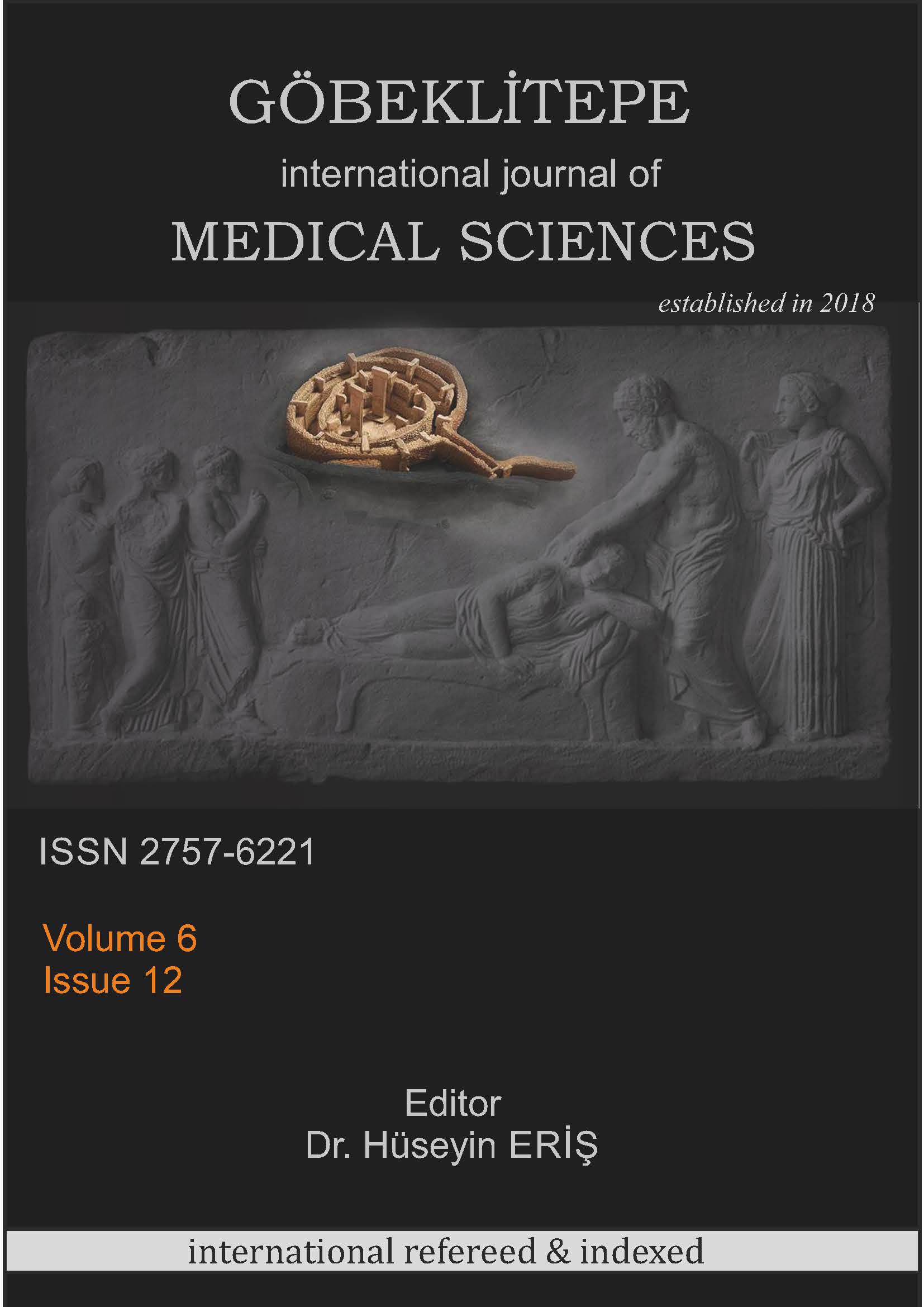The EXAMINATION OF OSTRACISM AND CYBERBULLYING IN ADOLESCENTS AND THEIR RELATIONSHIPS
The Ostracism and Cyberbullying in Adolescents
DOI:
https://doi.org/10.55433/gsbd/116.Keywords:
Ostracism, cyberbullying, Adolescent, University StudentsAbstract
aim of the study was to evaluate ostracism and cyberbullying experiences of adolescents and analyze the relation between them. The study was conducted in descriptive and cross-sectional type. The study was conducted at a university with 616 students under the age of 18 who agreed to add the research. Univariate analysis of the predictors of Ostracism Experience Scale for Adolescents (OES-A) and Cyberbullying Scale for Adolescents (BCS-A) scores was performed by Kruskal-Wallis test. The analysis of factors associated with high OES-A and BCS- A scores were studied by Chi-square or Fisher exact tests. 616 adolescents participated the study and 69.2% were female. Mean age was 17.75(+/- 0.44). The median score of BCS-A was 27.0(24- 65) and 50.3% of the participants had high BCS-A scores. The median OES-A score was 17.0(11-47) and 58.4% had high OES-A scores. The level of cyberbullying and ostracism of the students participating in the study was found to be high, and a positive significant relationship was found between both concepts. Conferences, panels and similar events should be organized for students to use technology correctly and in a suitable time. Medico-Social units should be established where university students can receive psychosocial support, especially for the group that may be at risk for ostracism and cyberbullying. It is also important for educators to know the risks arising from communication in the virtual environment and to provide support and counseling to risk groups in order to cope with these events.
References
Diarolf A. Ostracism and aggression: Influence of increasing provocation by pers on aggressive behaviour after acute experience of ostracism. Yayımlanmamış Yüksek Lisans Tezi. Universitat Trier, Trier.2010.
Omay U. Tüccar sınıfın Protestan hareketi desteklemesinin Maslow’un, ihtiyaçlar hiyerarşisi yaklaşımı açısından değerlendirilmesi. Sosyal Siyaset Konferansları Dergisi, 2007;52: 231-243.
Stout JG. When he doesn’t mean you: Gender-exclusive language as a form of subtle ostracism. Yayımlanmamış Yüksek Lisans Tezi. University of Massachusetts - Amherst, Massachusetts.2009
Hobcraft J. “Social Exclusion and the Generations”, (Ed.) Tania Burchardt, Julian Le Grand, David Piachaud, Understanding Social Exclusion, Oxford University Press, Oxford, U.K. 2002. p.1-22.
Eisenberger NI. Identifying the neural correlates underlying social pain: Implications for developmental processes. Human Development, 2006;49:273–93. doi.org/10.1159/000095580
Barnes SB. Understanding social media from the media ecological perspective. In E. Konijn, S. Utz, M. Tanis, & S. B. Barnes (Eds.), Mediated interpersonal communication. New York: Routledge.2008. p.14-33
Ekşi F, Ümmet D. Bir kişilerarası iletişim problemi olarak internet bağımlılığı ve siber zorbalık: Psikolojik danışma açısından değerlendirilmesi. Değerler Eğitimi Dergisi, 2013;11(25): 91-115.
Arıcak OT, Kınay H, Tanrıkulu T. Siber Zorbalık Ölçeğinin ilk psikometrik bulguları. Hasan Ali Yücel Eğitim Fakültesi Dergisi, 2012;17(1): 101-114.
Akın A, Uysal R, Akın Ü. Ergenler için ostrasizm (sosyal dışlanma) ölçeğinin Türkçe’ye uyarlanması. Kastamonu Eğitim Dergisi, 2016;24(2): 895-904.
Arısoy Ö. İnternet bağımlılığı ve tedavisi. Psikiyatride Güncel Yaklaşımlar, 2009;1(1): 55-67.
Ceyhan AA. Predictors of problematic internet use on Turkish university students. CyberPsychology & Behavior, 2008;11(3):363-366. doi.org/10.1089/cpb.2007.0112
Fortson BL, Scotti JR, Chen YC, Malone J, Del Ben KS. Internet use, abuse, and dependence among students at a southeastern regional university. Journal of American College Health, 2007;56(2): 137-144. doi.org/10.3200/JACH.56.2.137-146
Niemz K, Griffiths M, Banyard P. Prevalence of pathological Internet use among university students and correlations with self-esteem, the General Health Questionnaire (GHQ), and disinhibition. Cyberpsychology & Behavior, 2005;8(6):562-570. doi.org/10.1089/cpb.2005.8.562
TUİK Türkiye İstatistik Kurumu, Hanehalkı Bilişim Teknolojileri Kullanım Araştırması Erişim adresi: http://www.tuik.gov.tr/PreTablo.do?alt_id=1028, Erişim tarihi: 01.09.2019
Engelberg E, Sjöberg L. Internet use, social skills, and adjustment. Cyberpsychology & Behavior, 2004;7(1): 41-47. doi.org/10.1089/109493104322820101
Anderson KJ. Internet use among college students: An exploratory study. Journal of American College Health, 2001;50(1): 21-26. doi.org/10.1080/07448480109595707
Chak K, Leung L. Shyness and locus of control as predictors of internet addiction and internet use. CyberPsychology & Behavior, 2004;7(5):559-570. doi.org/10.1089/cpb.2004.7.559
Odacı H, Kalkan M. Problematic Internet use, loneliness and dating anxiety among young adult university students. Computers & Education, 2010;55(3):1091-1097. doi.org/10.1016/j.compedu.2010.05.006
Ashiq S, Majeed S, Malik F. Psychological predictors of cyber bullying in early adulthood. Health Science Journal, 2016;10(3): 1-9.
Jung YE, Leventhal B, Kim YS, Park TW, Lee SH, Lee M, ... Park JI. Cyberbullying, problematic internet use, and psychopathologic symptoms among Korean youth. Yonsei Medical Journal, 2014;55(3): 826-830. doi.org/10.3349/ymj.2014.55.3.826
Juvonen J, Gross EF. Extending the school grounds? Bullying experiences in cyberspace. Journal of School Health, 2008;78(9):496-505. doi.org/10.1111/j.1746-1561.2008.00335.x
Slonje R, Smith PK. Cyberbullying: Another main type of bullying? Scandinavian Journal of Psychology, 2008;49(2): 147-154. doi.org/10.1111/j.1467-9450.2007.00611.x
Farb AF, Matjasko JL. Recent advances in research on school-based extracurricular activities and adolescent development. Developmental Review, 2012;32(1): 1-48. doi.org/10.1016/j.dr.2011.10.001
Patrick H, Ryan AM, Alfeld-Liro C, Fredricks JA, Hruda LZ, Eccles JS. Adolescents' commitment to developing talent: The role of peers in continuing motivation for sports and the arts. Journal of Youth and Adolescence, 1999;28(6): 741-763.
Larson RW. Toward a psychology of positive youth development. American Psychologist, 2000;55(1): 170.
Robson BE. Competition in sport, music, and dance. Medical Problems of Performing Artists, 2004;19(4): 160-166. doi.org/10.21091/mppa.2004.4026
Bower JM, Carroll A. Benefits of getting hooked on sports or the arts: Examining the connectedness of youth who participate in sport and creative arts activities. International Journal of Child and Adolescent Health, 2015;8(2): 169-178.
Hinduja S, Patchin JW. Research summary: Cyberbullying victimization.2005.
Washington ET. An overview of cyberbullying in higher education. Adult Learning, 2015;26(1): 21-27. doi.org/10.1177/1045159514558412
Bottino SMB, Bottino C, Regina CG, Correia AVL, Ribeiro WS. Cyberbullying and adolescent mental health: systematic review. Cadernos de Saude Publica, 2015;31:463-475. doi.org/10.1590/0102-311X00036114
Lonigro A, Schneider BH, Laghi F, Baiocco R, Pallini S, Brunner T. Is cyberbullying related to trait or state anger? Child Psychiatry & Human Development, 2015;46(3):445-454.
Çivilidağ A, Cooper HT. Ergenlerde siber zorba ve öfkenin incelenmesi üzerine bir araştırma: Niğde İli örneği. International Journal of Social Science, 2013;6(1): 497-511.
Gamez-Guadix, M, Orue I, Smith PK, Calvete E. Longitudinal and reciprocal relations of cyberbullying with depression, substance use, and problematic internet use among adolescents. Journal of Adolescent Health, 2013; 53(4): 446-452. doi.org/10.1016/j.jadohealth.2013.03.030
Saylor CF, Nida SA, Williams KD, Taylor LA, Smyth W, Twyman KA, ... Spratt EG. Bullying and ostracism screening scales (BOSS): Development and applications. Children's Health Care, 2012;41(4): 322-343. doi.org/10.1080/02739615.2012.720962
Pharo H, Gross J, Richardson R, Hayne H. Age-related changes in the effect of ostracism. Social Influence, 2011;6(1): 22-38. doi.org/10.1080/15534510.2010.525852
Downloads
Published
Versions
- 2024-07-02 (2)
- 2023-06-28 (1)
How to Cite
Issue
Section
License
Copyright (c) 2023 Göbeklitepe Sağlık Bilimleri Dergisi

This work is licensed under a Creative Commons Attribution 4.0 International License.




